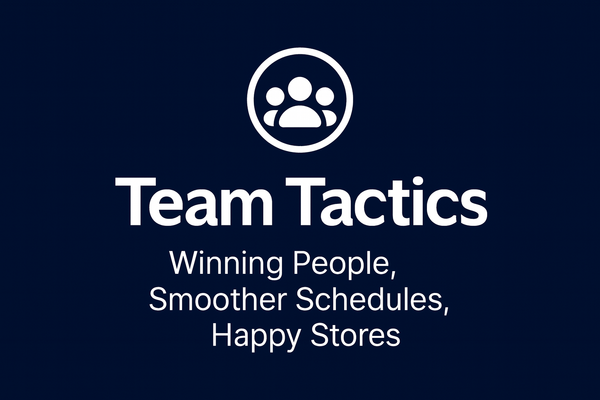Creating a Daily Cash Flow Routine: From Motion to Meaningful Movement in Store Finances
Most store owners track sales—but few manage cash flow daily. Learn how a simple 10-minute routine turns data into clarity, prevents surprises, and fuels smarter growth. Motion is busywork. Movement drives profit.

Most independent convenience store owners have a rough feel for their daily sales—but the difference between businesses that thrive and those that tread water? A disciplined daily cash flow routine. Research consistently shows that stores tracking day-to-day inflows and outflows spot leaks, avoid crunches, and outpace competitors in both agility and bottom-line growth.
Consider this: nearly half of small retail failures are ultimately traced back to cash flow mismanagement—not market share, not inventory, but unclear, inconsistent routines for seeing where the money actually goes each day. Simply watching sales reports (motion) isn’t enough; real progress comes from building a repeatable, actionable system that delivers clarity, confidence, and control. That’s movement.
Why a Daily Cash Flow Routine Matters
A cash flow routine is far more than an accounting ritual; it’s the shopkeeper’s stethoscope. Owners who spend 5–10 minutes each morning or close-of-day noting cash in, cash out, and what’s coming due are likelier to make better decisions about purchasing, staffing, and promotions. The founders of Office Prodigy experienced this first-hand: By implementing a simple daily tracking habit, they identified overspending on non-essentials and redirected those funds into moves that actually shifted results—fueling a surge in operational resilience and opportunity capture.
Just like the best visual merchandising routines, daily cash flow discipline keeps surprises at bay and creates bandwidth for proactive moves, not emergency fixes.
Getting Practical: What and How to Track
The essentials:
- Sales Deposits: Log total receipts—cash, cards, mobile payments, lottery, ATMs, and other in-store services.
- Daily Debits: Note all outgoing cash—vendor invoices paid, payroll runs, change orders, utilities, unexpected repairs, transfers to savings, or loan payments.
- Pending and Upcoming Payments: Flag bills or auto-debits scheduled for the next few days so you’re ready—not blindsided.
- Physical vs. Digital: Some top operators use a simple two-column Excel sheet: Date, In/Out, Category, Amount, plus a “Notes” field for context. Others get robust with digital dashboards pulling directly from bank feeds or POS summaries—the best system is the one you’ll actually use.
As seen in Bim’s Bytes “Budget Buster” challenge, even one week of diligent tracking often reveals eye-opening trends—a daily $6 habit here, a forgotten vendor there. The lesson? Your money always tells a story if you’re willing to read it.
Turning Routine Data Into Real Decisions
It’s easy to default to “motion” by logging daily totals just to check a box for compliance or habit. But, as Jeff Bezos famously challenged his Amazon teams, the question isn’t “Are we busy?” but “Are we moving the business forward?”
- Motion: Shuffling receipts into a folder or letting the POS closeout report pile up unread.
- Movement: Using those numbers to delay non-essential orders until receivables land, schedule staff only when cash is strong, or jump on a supplier deal because you know you can float the payment.
Owners who act on cash flow signals—rather than just collecting them—avoid payroll panics, bounce fewer checks, and invest confidently in the moments that matter.
Building and Sustaining the Routine
Start small. For the next seven days, track every transaction—no matter how minor. Summarize with a basic chart and reflect: Where does most cash go? Which days are tightest? What surprised you?
Automate what you can. Use POS or bank feed integrations for recurring entries; set calendar reminders for daily reviews; assign a backup so this routine never lapses during vacation or illness.
Make it a habit. The best routines don’t require willpower—they become as regular as opening the store. Layer cash flow review into your shift change, daily management huddles, or as part of your evening closeout.
Level up over time. Advance from simple logs to quick weekly reviews: Did we finish with more cash than last Friday? Are most days positive, or are there avoidable gaps? Let questions—not just numbers—drive improvement.
Share learnings. Have your team spot trends and solutions, not just present data. Celebrate when cash flow improvements allow a bonus, new equipment, or seizing a supplier discount.
Final Word: Why Cash Flow Movement Wins
The store owners who move beyond passive tracking—who redesign routines to act on daily financial signals—build businesses ready for challenge and change. Motion alone is noise; movement creates compounding advantage.
This article is part of the weekly "Profit Power" series from C-Store Thrive.
Found this analysis helpful? Share C-Store Thrive with fellow convenience store owners who want to turn routine tracking into long-term financial momentum!





